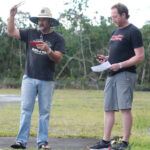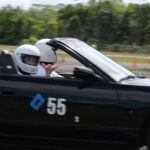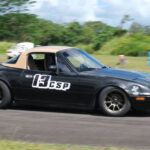Big Islanders flock to monthly autocross events




Once a month, people from all walks of life travel from across the Big Island to take part in an extraordinary activity at the Hilo Go-Kart Track.
That activity is autocross, a thrilling hobby which makes regular folks with regular cars feel like racecar drivers.
ADVERTISING
Anyone with any car (other than anything with a high center of gravity) can take part in ripping around the track in a heartracing fashion, taking on challenging courses and competing to clock the best time.
Autocross is made possible by the Sports Car Club of America (SCCA), which hosts events all over the mainland and on O‘ahu and Maui. The Big Island chapter of the SCCA, however, is incredibly unique. Most autocross events see hundreds of drivers line up and wait just to drive for a total of less than two minutes.
Here, the island’s isolation affords its autocross drivers a rare level of freedom, autonomy and camaraderie. Drivers spend an uncommonly extensive amount of time on the course, and the club’s close-knit and friendly character provides a wholesome, enriching and relaxed social atmosphere to supplement the excitement of racing.
Both seasoned car-nuts and total newbies can feel right at home in the Big Island SCCA. Its drivers span everyone from lifelong mechanics to rookies still learning to drive stick shift.
All it takes to drive is the right mindset, or as the saying goes at the Big Island SCCA; “the hardest nut to tighten is the one behind the wheel.”
In the Big Island SCCA, a cornucopia of cars can be seen at the track. Mazda Miatas are the single most heavily represented car, but all sorts of others are there too — including Corvettes, Porsches, Hondas, a Dodge Challenger SRT Hellcat, an Austin Healy 3000, a 1962 Morris Mini and more.
In autocross, drivers register their personal cars with the SCCA and head down to the track. Depending on how modified one’s car is, it will receive a classification which constitutes a certain handicap for the time it takes them to complete a lap around the track. Simply put — if someone has modified their car, their finishing time will be adjusted accordingly.
Cones are placed throughout the track to alter the course for each monthly meet. Hitting cones or sliding off of the track will result in penalities to one’s time — and hitting too many cones or driving completely off of the track will result in a DNF (Did Not Finish).
Big Island SCCA Regional Executive Ron Carter has been driving autocross for about seven years now, and found out about it through a friend. Carter bought a used 2001 Miata and first came to the Hilo track expecting to “clean up,” but came in dead last.
“One thing about autocross,” said Carter, “is that it has a tendency to really humble those who have a chip on their shoulder — because you find out just how touchy everything is. This is not a speed driving event, it’s a technical driving event.”
The courses — which are complex and full of tight turns — are designed to challenge even the most seasoned driver, and are laid out so precisely and creatively that one might assume they were designed by an engineer — because they are. Joel Payne, a mechincal engineer at the W.M. Keck Observatory and five-year SCCA member, has been designing the Big Island SCCA’s courses for the past three years.
“(Autocross) brings together a really diverse group of folks,” Payne said. “It appeals to the rich and the poor, the young and the old, pretty much all ethnicities — several ladies out driving today. It’s an ecclectic group of people with an ecclectic group of cars, having fun on a beautiful day in Hilo. It’s just a great place to be.”
Payne said that working on cars was what got him into engineering in the first place. He races in his “Frankenstein,” a 1990 Mazda RX-7, in which he installed a Corvette engine.
Travis Tjarks is another one of the Big Island SCCA’s long-time car guys, but found autocross to be a whole different beast than what he was used to. Tjarks drives a supercharged Lexus SC400 that he modified on a budget.
“I’m a truck guy,” Tjarks said, “but then I picked up this SC400 to put the v8 in my 4Runner — and I ended up picking up three or four other ones, so I had all the coilovers, tires, all the stuff. Then I found out about this, I didn’t even know this place existed. At first my car was total junk and my tires were junk, so I was just here learning.”
Big Island SCCA has been active for about 20 years on and off. Most of its current drivers have been members for less than ten years, but some have been in it for the long haul — such as Glenn Swanson, a Puna-based realtor and SCCA member since 2008 — who raised his now 25-year-old son, Jesse, around autocross.
“I tought him how to drive,” Swanson said, “and now recently, he took number one and I was number two.”
Many of the Big Island SCCA’s members were introduced to autocross through friends and family. Autocross also brings together people from all over the Island. Carter said he estimates that most of the Big Island SCCA’s membership lives on the Kona side, with several also traveling from Waimea, Puna and Ka‘u.
Hosting each race is a collaborative process. Drivers, who usually number 20-35 per meet, are divided into three heats at random. Those awaiting their heat or who have already finished can help work the course. Coursework includes watching corners to see if drivers hit cones or went off track, working the starting line, calculating times, handing out times to finishers and more. Electronic equipment is used to time starts, corner turns and finishes.
Safety is a priority — so courseworkers carry fire extinguishers, drivers wear helmets and closed-toed shoes, all vehicles must have up-to-date safety inspections, and insurance is provided by the track in case of any accidents. However, Carter said that he has never seen any injuries nor needed to use one of the fire extinguishers in all his years at the track.
Drivers measure all sorts of minutiae when it comes to racing. Many use the grippiest street-legal tires possible, and warm up their tires before each race — because hot tires grip the track better. At the start of each day, courseworkers use a blower to remove as many rocks and other debris from the track as possible — and when drivers do their pre-race walkthroughs, they can be seen kicking all stray pebbles off of the track.
Drivers also note every detail when it comes to their cars. Some remove all possible excess weight, including their air conditioning — and some debate whether having a passenger slows them down or adds helpful balance for better handling. While some drivers race their daily commuter cars, many have purchased (usually used) cars specifically for autocross.
As members of a national institution, SCCA drivers who clock good enough times can qualify to compete in national autocross competitions. But shipping one’s car all the way to the mainland is quite an expense and a headache to undertake just for a race, so Big Island SCCA drivers have developed a different philosophy from many when it comes to their times. They are mostly uncompetitive, and simply strive to challenge their personal best and support their peers.
“The points that you accumulate after they adjust your time are fairly unimportant to most of us,” Carter said. “We’re all just out here to just drive as fast as we can around there, you know. Nothing to run into, just don’t slide all the way off the track — because you’re going to lose your run.”
Since events are only held once a month, autocrossers drive rain or shine — and some gladly accept the challenge of racing in the rain.
The track is maintained by the county, and SCCA members hope that an increase in membership will encourage the county to make some much-needed repairs — as the Hilo climate is not kind to the track.
“It doesn’t take anything special to drive here,” Carter said. “It’s cheap, I think we pay 30-35 bucks per day at the track, if you’re not a member I think it’s a little more. Overall, it’s very cheap entertainment — anyone can do it.”
The next Big Island SCCA autocross event will be held May 7th. Those interested in participating can find out more at www.bigislandscca.org.





